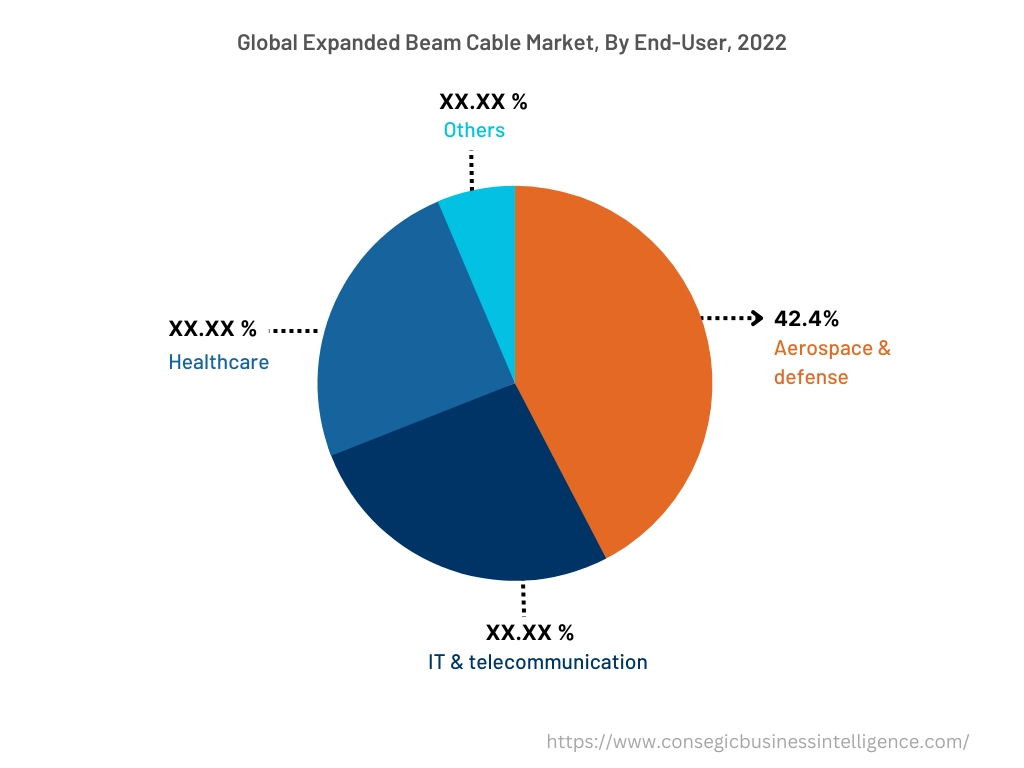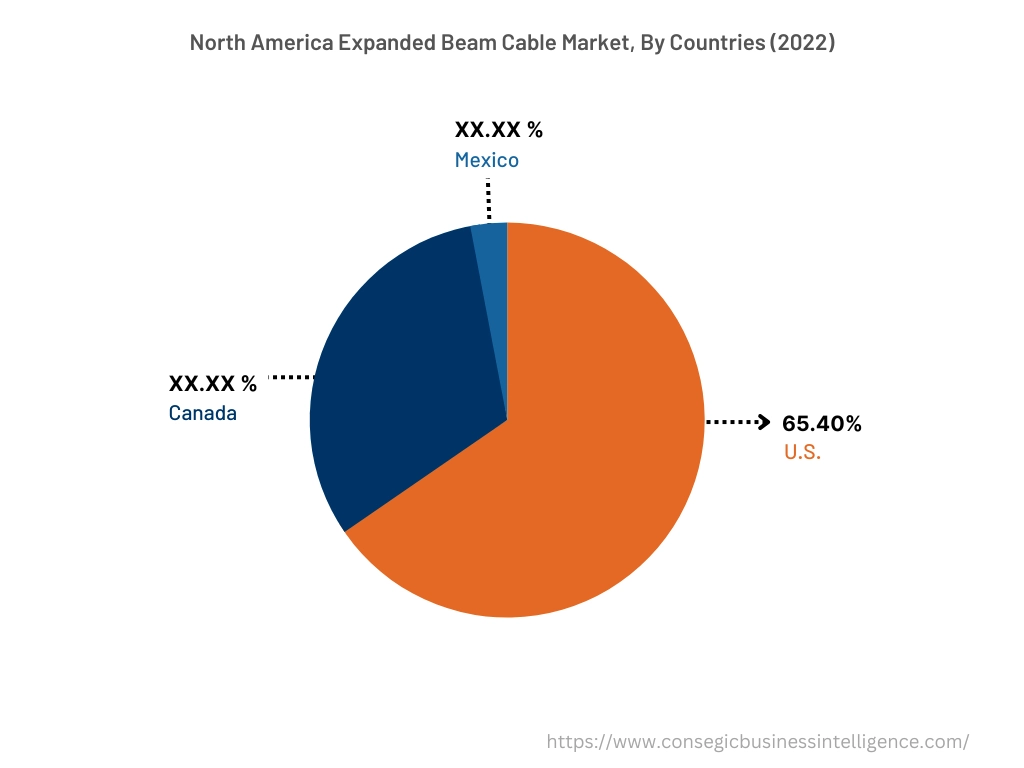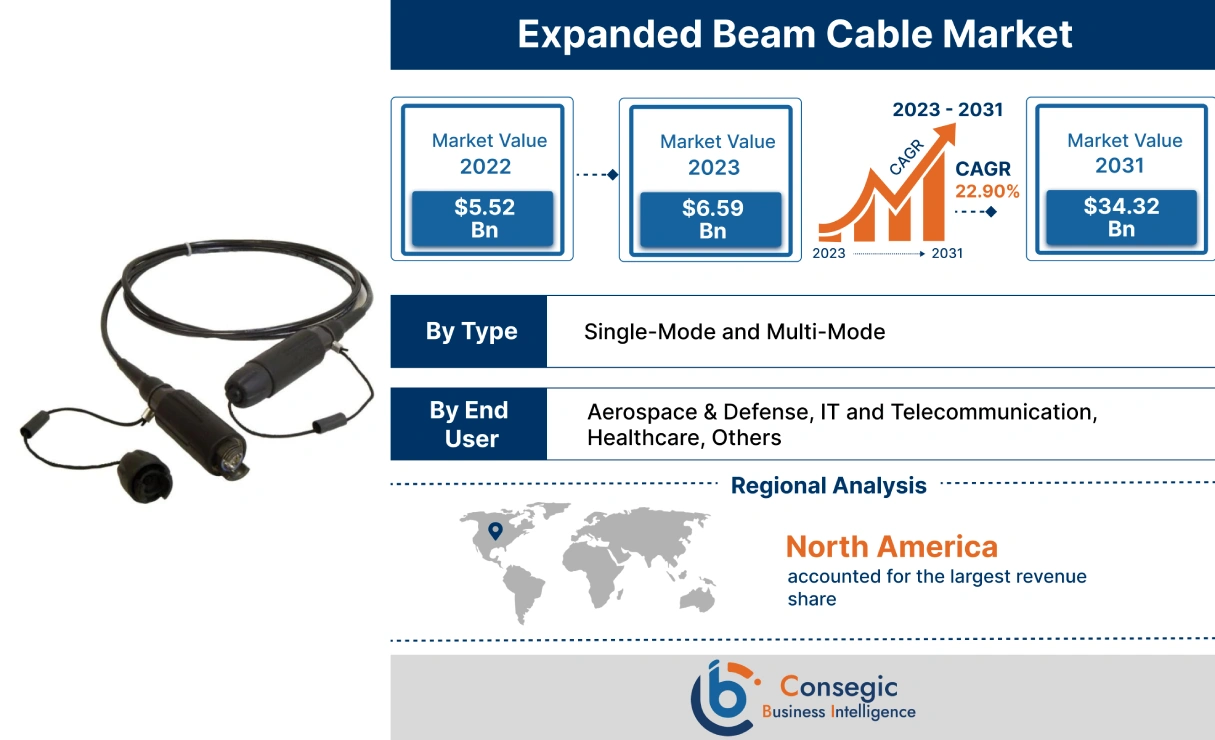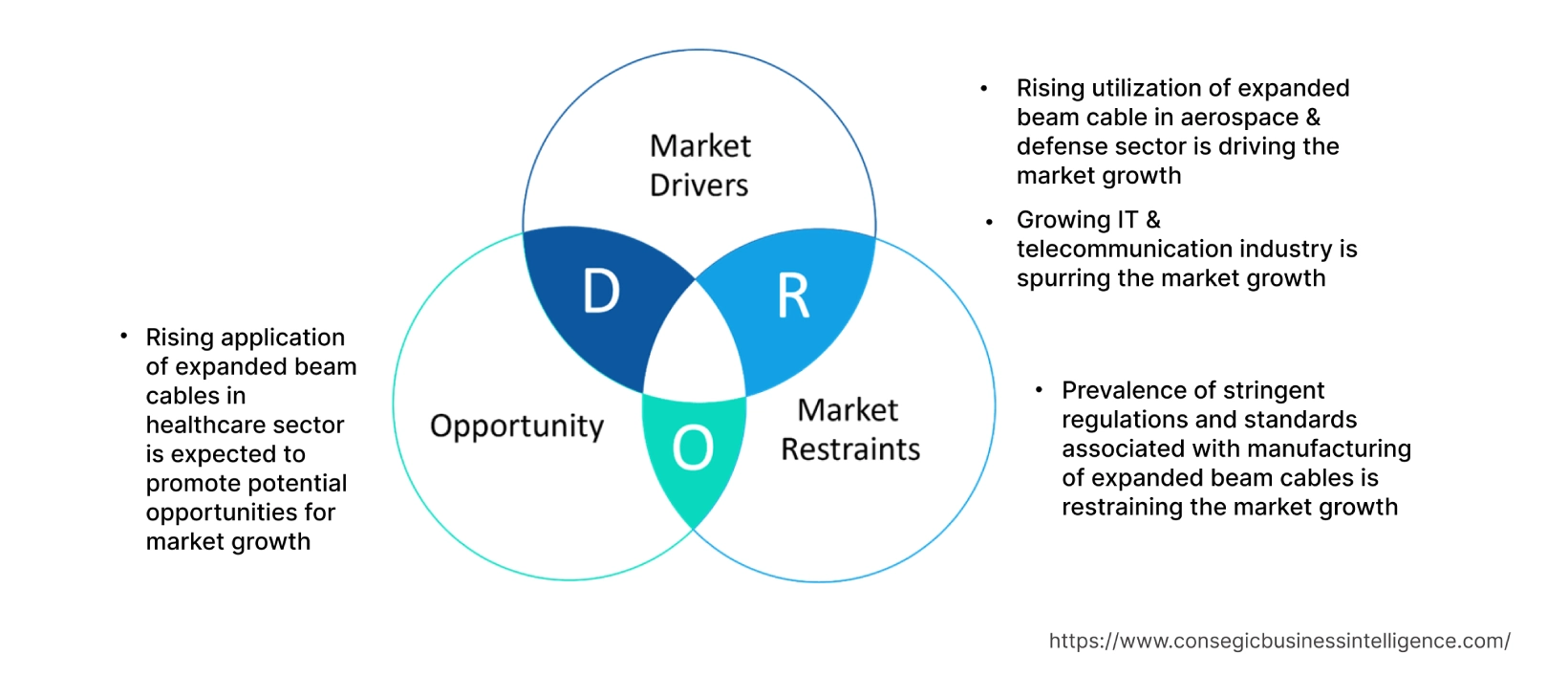- Summary
- Table Of Content
- Methodology
Expanded Beam Cable Market Introduction :
Expanded Beam Cable Market is estimated to reach over USD 34.32 Billion by 2031 from a value of USD 5.52 Billion in 2022 and is projected to grow by USD 6.59 Billion in 2023, growing at a CAGR of 22.90% from 2023 to 2031.
Expanded Beam Cable Market Definition & Overview:
Expanded beam cables refer to a type of fiber optic cable that is particularly designed to provide reliable optical connections in harsh, outdoor environments. Moreover, expanded beam cables offer a range of benefits including resistance to extreme environmental conditions, high strength, lightweight and robust design, high tensile load, and reliable operation among others. The aforementioned benefits of expanded beam cables are key determinants for increasing its utilization in aerospace & defense, IT and telecommunication, healthcare, and other industries.
Expanded Beam Cable Market Insights :
Key Drivers :
Rising utilization of expanded beam cable in aerospace & defense sector is driving the market growth
Expanded beam cables are primarily used in the aerospace & defense sector for applications ranging from commercial aircraft to military platforms. Moreover, expanded beam cables are utilized in aerospace & defense sector to provide seamless network connectivity and high-speed data transmission in applications including military vehicles, antenna systems, radar systems, and tactical military communications. Moreover, the characteristics of expanded beam cables including high resistance to shock and vibrations and the ability to ensure reliable optical connections in harsh environments are prime aspects for increasing its utilization in aerospace & defense sector.
Factors including growing commercial flight activities, rising aircraft production, and increasing investments in air defense systems are fostering the growth of the aerospace & defense sector.
For instance, Boeing, a U.S.-based airline company, delivered 99 commercial jets in the fourth quarter of 2021, witnessing a significant increase of 68% as compared to 59 deliveries in the fourth quarter of 2020. Additionally, in December 2022, the Department of Defense of the United States invested around USD 50 million for the automation of future army ground vehicles that is led by the Army's Robotic Combat Vehicle program. The investment aims at supporting military vehicles designed for surveillance, reconnaissance, and high-risk missions.
Thus, the growth of aerospace & defense sector is increasing the adoption of expanded beam cables for application in military vehicles, antenna systems, radar systems, and tactical military communications, in turn driving the growth of the market.
Growing IT & telecommunication industry is spurring the market growth
Expanded beam cables are primarily used in the IT & telecommunication sector for various applications including base stations and communication systems among others. Expanded beam cables are used to support 5G networks and are capable of providing the necessary infrastructure for the deployment of 5G, owing to its ability to provide reliable optical connections in harsh environments along with high-speed data transmission capabilities.
Factors including the increasing demand for wireless communication, growing deployments of 5G infrastructure, and rising adoption of smartphones and advanced communication devices are among the vital prospects driving the growth of the IT & telecommunication industry.
For instance, according to the Ookla 5G Map, the overall 5G deployments reached up to 112 countries in November 2021, depicting an increase of 13% in contrast to 99 countries in November 2020. Additionally, Ookla further states that the total 5G deployments increased significantly and reached up to 85,602 deployments in 2021 in contrast to 17,428 deployments in 2020.
Hence, the growing telecommunication industry is increasing the adoption of expanded beam cables for its application in telecommunication base stations and communication systems for providing reliable signal and connectivity solutions, in turn driving the growth of the market.
Key Restraints :
Prevalence of stringent regulations and standards associated with manufacturing of expanded beam cables is restraining the market growth
Expanded beam cables are used in various industries including aerospace & defense, IT & telecommunication, healthcare and others. However, expanded beam cable manufacturers have to compulsorily comply with various stringent standards associated with the production of expanded beam cables, which is a prime factor restricting the market growth.
For instance, expanded beam cable manufacturers have to comply with various regulations such as RoHS (Restriction of Hazardous Substances in Electrical and Electronic Equipment) Directive, EU REACH (Registration, Evaluation, Authorization and restriction of Chemicals) Regulation (EC) No. 1907/2006, and others.
Additionally, expanded beam cable designed for military & defense applications must comply with MIL standards including MIL-DTL-38999, MIL-C-85045, and others approved for use by the United States Department of Defense (DOD).
Therefore, the prevalence of the aforementioned regulations and standards associated with the manufacturing of expanded beam cables is constraining the growth of the market.
Future Opportunities :
Rising application of expanded beam cables in healthcare sector is expected to promote potential opportunities for market growth
The rising application of expanded beam cables in healthcare sector is expected to present potential opportunities for the growth of the expanded beam cable market. Expanded beam cables are often used in healthcare sector, particularly for application in medical devices, attributing to their superior bandwidth, resistance to electromagnetic interference, lower weight, and tolerance to dust and other contaminants.
Factors including the increasing trend in healthcare expenditure, rising incidence of diagnostics and surgical procedures, and growing investments in advanced medical equipment are expected to promote lucrative growth prospects for the market.
For instance, according to American Medical Association, the total healthcare spending in the United States reached up to USD 4.3 trillion in 2021, witnessing a growth of in comparison to 2020. Healthcare expenditure in the United States accounted for 18.3% of the total GDP in 2021. Additionally, the European Commission invested around USD 6 billion budget during the 2021-27 period to support the healthcare sector in Europe.
Therefore, rising investments in the healthcare sector are projected to increase the integration of expanded beam cables for application in medical devices, in turn stimulating opportunities for market growth during the forecast period.
Expanded Beam Cable Market Report Insights :
| Report Attributes | Report Details |
| Study Timeline | 2017-2031 |
| Market Size in 2031 | USD 34.32 Billion |
| CAGR (2023-2031) | 22.90% |
| By Type | Single-Mode and Multi-Mode |
| By End-User | Aerospace & Defense, IT and Telecommunication, Healthcare, Others |
| By Region | North America, Europe, Asia-Pacific, Latin America, and Middle East & Africa |
| Key Players | Harting Technology Group, Bel Fuse Inc., Radiall, Neutrik AG, TE Connectivity, Smiths Interconnects, X-Beam Tech Co. Ltd., Warren & Brown Networks, 3M, Molex, Glenair, Amphenol Corporation |
Expanded Beam Cable Market Segmental Analysis :
Based on the Type :
Based on the type, the market is bifurcated into single-mode and multi-mode. The multi-mode segment accounted for the largest revenue share in the year 2022. Multi-mode expanded beam cables comprise of a larger core diameter which allows the propagation of several light modes. Moreover, multi-mode expanded beam cables offer several benefits including higher speed, high bandwidth, and the ability to enable several mode optical signals to be transmitted at once. The above benefits of multi-mode expanded beam cables are increasing its application in aerospace & defense, healthcare, and IT & telecommunication sectors among others.
For instance, according to the European Medical Technology Industry, the medical device sector in the U.S. and Europe accounted for 43.5% and 27.3% of the total share of the global medical device sector in 2021. It further states that the medical device sector in Germany accounted for 25.8% of the total share of the European medical device industry in 2021, followed by France with 14.3%, UK with 10.4%, Italy with 9.0%, and Netherlands with 6.4% among others. Thus, the rising production of medical devices is among the key factors driving the adoption of multi-mode expanded beam cables for application in medical diagnostics, monitoring, and imaging equipment, in turn contributing to the growth of the market.
The single-mode segment is anticipated to register fastest CAGR growth during the forecast period. Single mode expanded beam cables are capable of carrying a single beam of light and are ideal for deployment in long-distance telecommunication applications. The core diameter of single-mode cables is much smaller as compared to multimode cables. Moreover, single-mode expanded beam cables are relatively less expensive and offer multiple benefits including faster transmission over long distances, lower integrity loss, and others. The above benefits of single-mode expanded beam cables make it ideal for utilization in IT & telecommunication, and other industries.
For instance, according to Viavi Solutions Inc., the overall number of cities across the world with 5G deployments reached 1,947 as of January 2022, along with the addition of 635 new 5G cities in 2021. Therefore, the growth of telecommunication sector is anticipated to drive the utilization of single-mode expanded beam cables for utilization in telecom base stations and communication systems, in turn fueling market growth during the forecast period.
Based on the End-User :
Based on the end-user, the market is segregated into automotive, consumer electronics, aerospace & defense, healthcare, and others. The aerospace & defense segment accounted for the largest revenue share of 42.4% in the year 2022. Factors including rising aircraft production, growing commercial flight activities, and increasing investments in air defense systems are driving the growth of the aerospace & defense sector.
For instance, in December 2022, Dassault Aviation, a French manufacturer of business jets and military aircraft, launched a Rafale fighter aircraft for its application in the French military procurement agency called the Directorate General of Armaments. Therefore, the growth of aerospace & defense sector is driving the adoption of expanded beam cables for providing high-speed data transmission and seamless network connectivity in applications including military vehicles, antenna systems, radar systems, and tactical military communications, in turn proliferating the growth of the market.
IT & telecommunication segment is expected to witness fastest CAGR growth during the forecast period. The growth of IT & telecommunication segment is attributed to several factors including the growing demand for wireless communication, increasing penetration of 5G infrastructure, and rising need for high-speed data and internet services.
For instance, according to GSM Association, most of the countries in European region deployed commercial 5G services in 2021, while approximately two thirds of regional operators launched 5G networks. GSM Association further states that 5G connections across the European region are projected to reach 311 million by the end of 2025. Therefore, the growth of telecommunication sector is expected to drive the adoption of expanded beam cables for utilization in base stations and broadcast stations among others, in turn proliferating the growth of the market during the forecast period.

Based on the Region :
The regional segment includes North America, Europe, Asia Pacific, Middle East and Africa, and Latin America.

North America accounted for the largest revenue share of USD 2.13 Billion in 2022 and is expected to reach USD 13.23 Billion by 2031, registering a CAGR of 22.9% during the forecast period. In addition, in the region, the U.S. accounted for the maximum revenue share of 65.40% in the same year. The adoption of expanded beam cables in the North American region is primarily driven by its usage in IT & telecommunication, aerospace & defense, healthcare, and other sectors. Additionally, the rising utilization of expanded beam cables in telecommunications infrastructure including base station and fiber optic communication systems is among the significant factors driving the market growth in the region.
For instance, according to the GSM Association, the total deployment of 5G connection across North America reached approximately 140 million as of 2022. Hence, the growing telecommunication industry is fostering the utilization of expanded beam cable for high-speed data transfer and communication applications, in turn driving market growth in the North American region. Further, increasing investments in healthcare and aerospace & defense industries are projected to stimulate lucrative growth prospects for the market to grow in North America during the forecast period.
Asia-Pacific is expected to register the fastest CAGR growth of 23.1% during the forecast period. The rising pace of industrialization and development is facilitating lucrative growth aspects for the market in the region. Moreover, factors including the growth of multiple industries such aerospace & defense, IT & telecommunication, and others are driving the market growth for expanded beam cables in the Asia-Pacific region.
For instance, according to Invest India, the Government of India allocated USD 70.6 billion to the Ministry of Defense as the part of its Union Budget 2022-23. The primary focus of the budget allocation to the Indian Ministry of Defense is to help in the development of new unmanned vehicles and systems, military ground vehicles, and other related systems. Hence, rising investment in military & defense sector is anticipated to drive the utilization of expanded beam cables for providing reliable network connectivity and high-speed data transmission in applications including military vehicles, tactical military communications, and others thereby, driving market growth in the Asia-Pacific region during the forecast period.

Top Key Players & Market Share Insights:
The expanded beam cable market is highly competitive with major players providing expanded beam cable to the national and international markets. Key players are adopting several strategies in research and development (R&D), product innovation, and application launches to hold a strong position in expanded beam cable market. Key players in the expanded beam cable market include-
- Harting Technology Group
- Bel Fuse Inc.
- 3M
- Molex
- Glenair
- Amphenol Corporation
- Radiall
- Neutrik AG
- TE Connectivity
- Smiths Interconnects
- X-Beam Tech Co. Ltd.
- Warren & Brown Networks
Recent Industry Developments :
- In June 2020, TE Connectivity introduced its expanded beam optical pin and socket termini that are available in multimode and single mode variations. EB16 termini is capable of providing low sensitivity to contamination, easier optical alignment, and consistent performance over thermal changes among others.
Key Questions Answered in the Report
What is expanded beam cable? +
Expanded beam cables refer to a type of fibre optic cables that are particularly designed to provide reliable optical connections in harsh, outdoor environments.
What specific segmentation details are covered in the expanded beam cable report, and how is the dominating segment impacting the market growth? +
For instance, by type segment has witnessed multi-mode expanded beam cables as the dominating segment in the year 2022, owing to its increasing utilization in aerospace & defence, healthcare, and IT & telecommunication sectors among others.
What specific segmentation details are covered in the expanded beam cable market report, and how is the fastest segment anticipated to impact the market growth? +
For instance, by end-user segment has witnessed IT & telecommunication as the fastest-growing segment during the forecast period due to the rising adoption of expanded beam cables in telecommunication base stations and communication systems for providing reliable signal and connectivity solutions.
Which region/country is anticipated to witness the highest CAGR during the forecast period, 2023-2031? +
Asia-Pacific is anticipated to register fastest CAGR growth during the forecast period due to rapid pace of industrialization and growth of multiple industries such as aerospace & defence, IT & telecommunication, and others.


